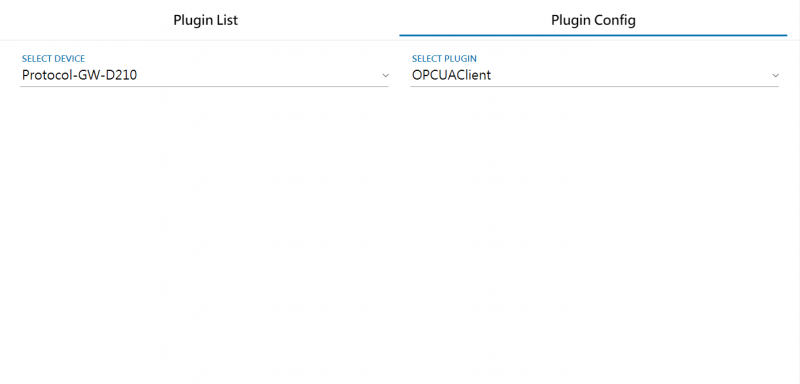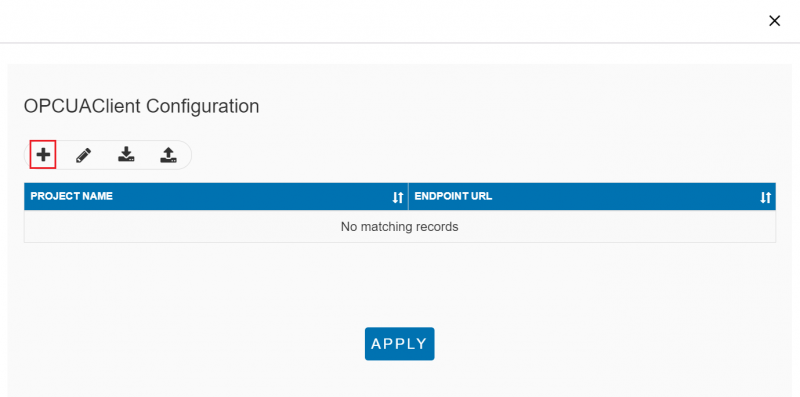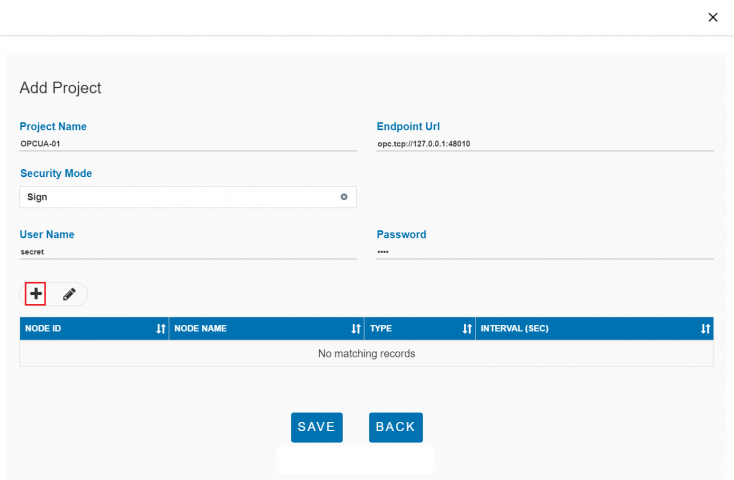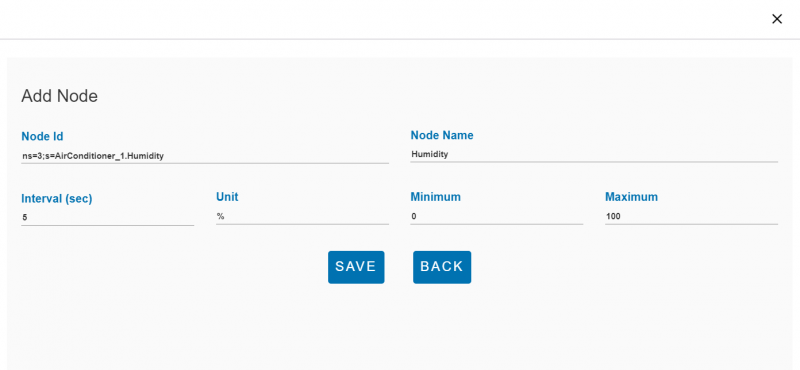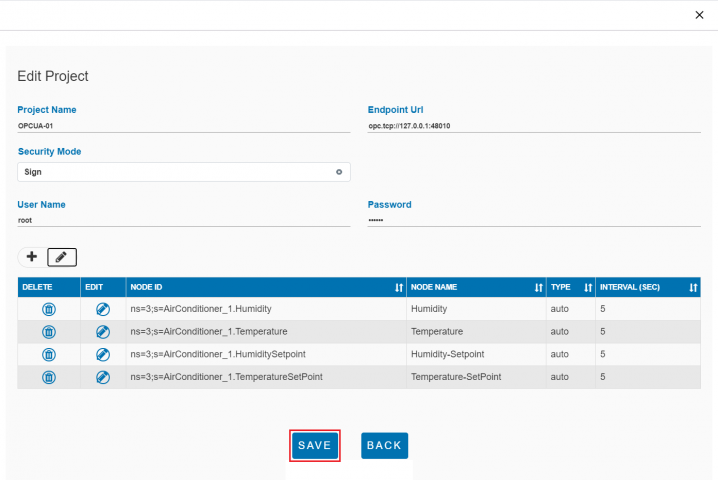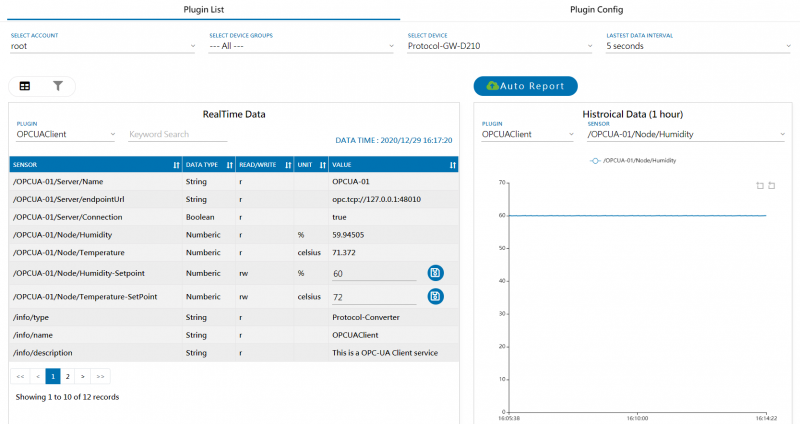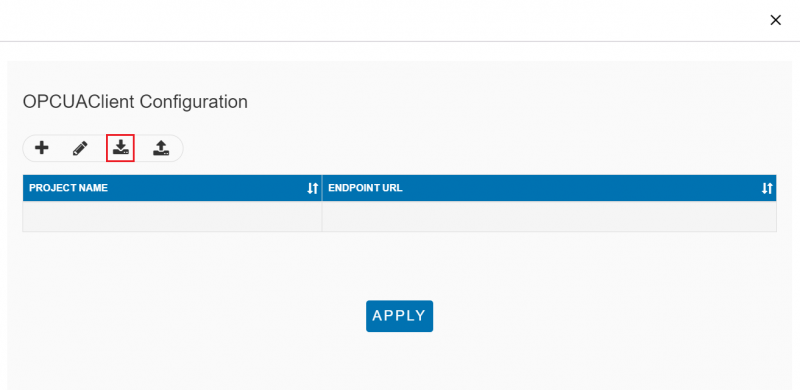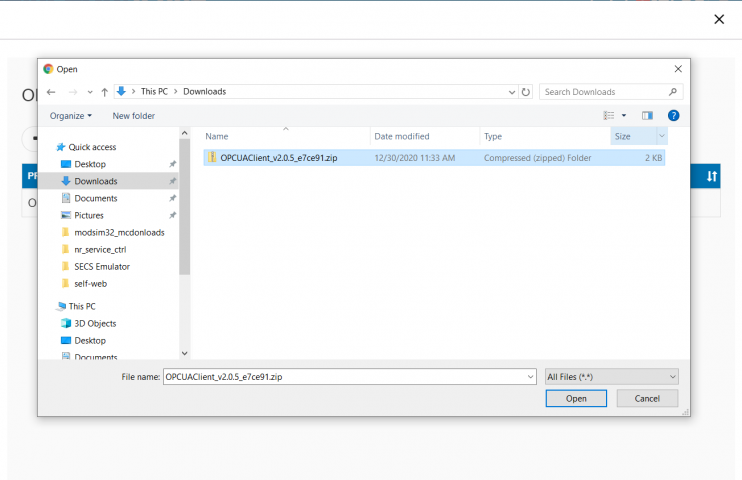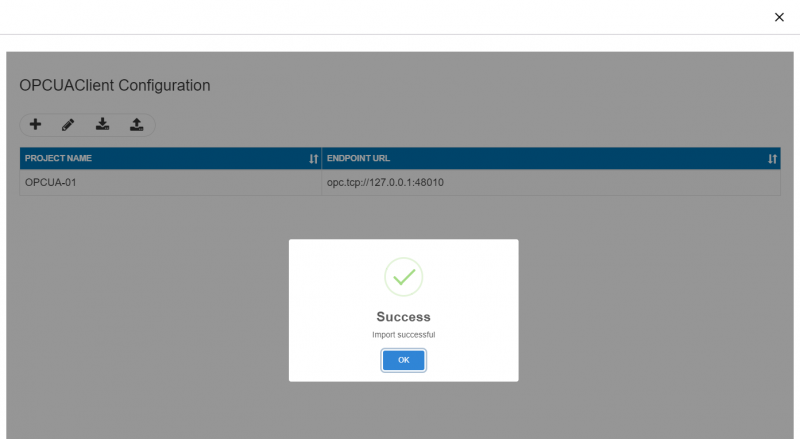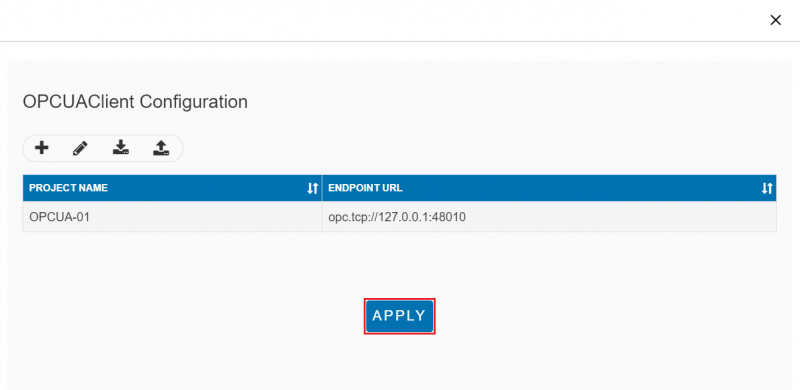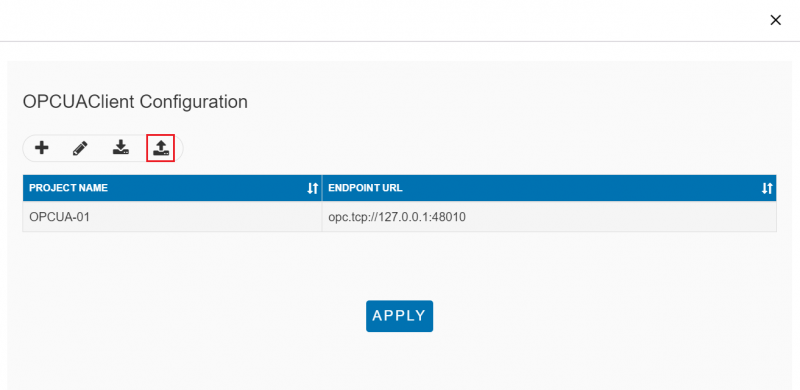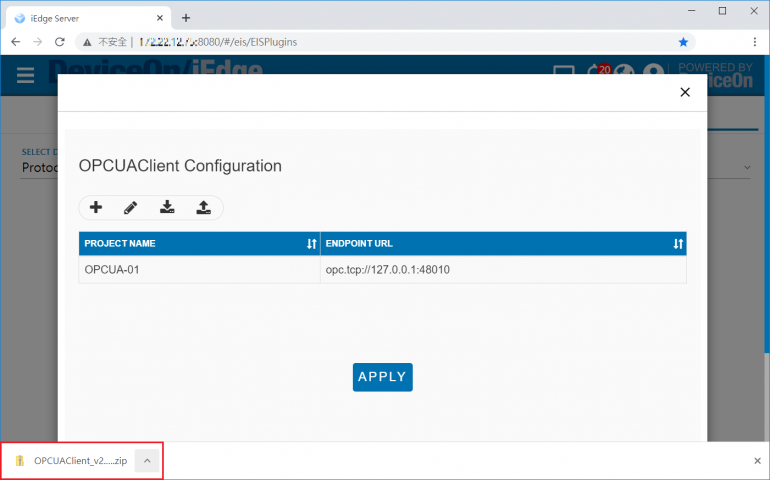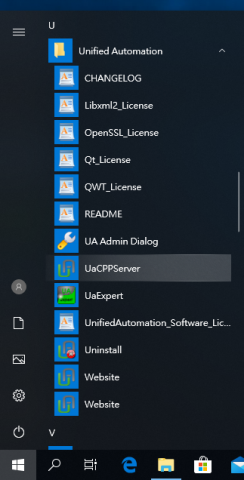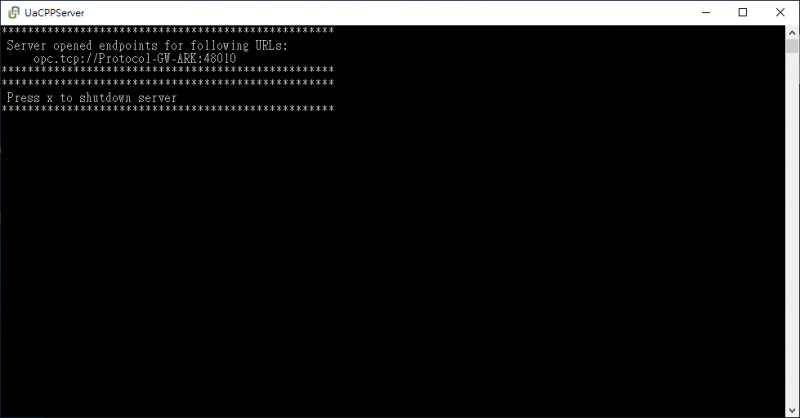Difference between revisions of "OPC-UA Client"
(→Configuration) |
|||
| Line 42: | Line 42: | ||
2. Launch the installer to install it to the machine. | 2. Launch the installer to install it to the machine. | ||
| + | |||
| Line 49: | Line 50: | ||
Step 1. Go to "Plug-ins" / Plugin Config to select OPCUAClient Plug-in | Step 1. Go to "Plug-ins" / Plugin Config to select OPCUAClient Plug-in | ||
| − | [[File:Opcua config UtQlI7p.png|border|800x480px | + | [[File:Opcua config UtQlI7p.png|border|800x480px]] |
Setp 2. Click "+" to add OPCUA project | Setp 2. Click "+" to add OPCUA project | ||
| − | + | [[File:Opcua config uNA2oIS.png|border|800x480px]] | |
Setp 3. Edit new OPCUA Project | Setp 3. Edit new OPCUA Project | ||
| − | + | [[File:Opcua config 4nAWV6Z.png|border|800x480px]] | |
* PROJECT NAME: Enter a project name in unique | * PROJECT NAME: Enter a project name in unique | ||
* ENDPOINT URL: Endpoint URL of OPCUA Server | * ENDPOINT URL: Endpoint URL of OPCUA Server | ||
| − | + | [[File:Opcua config N19A761.png|border|800x480px]] | |
* SECURITY MODE: None / Sign | * SECURITY MODE: None / Sign | ||
| Line 70: | Line 71: | ||
Setp 4. Click "+" to add Sensor Node | Setp 4. Click "+" to add Sensor Node | ||
| − | + | [[File:Opcua config bgenwaL.png|border|800x480px]] | |
Step 5. Edit Node Information | Step 5. Edit Node Information | ||
| − | + | [[File:Opcua config UeyMgDP.png|border|800x480px]] | |
* NODEID: Node ID you'd like to monitor. | * NODEID: Node ID you'd like to monitor. | ||
| Line 82: | Line 83: | ||
Step 6. Click "+" to add multiple nodes | Step 6. Click "+" to add multiple nodes | ||
| − | + | [[File:Opcua config BlLUlTV.png|border|800x480px]] | |
Step 7. Click {{:./img/opcua-config-E03-edit.png}} to delete or edit sensor node info | Step 7. Click {{:./img/opcua-config-E03-edit.png}} to delete or edit sensor node info | ||
| − | + | [[File:Opcua config jDMeU3E.png|border|800x480px]] | |
Step 8. Click "Save" to complete node editing. | Step 8. Click "Save" to complete node editing. | ||
| − | + | [[File:Opcua config qYQ76Qq.png|border|800x480px]] | |
Setp 9. Click "Apply" to set and apply the new setting | Setp 9. Click "Apply" to set and apply the new setting | ||
| − | + | [[File:Opcua config 4A88VkH.png|border|800x480px]] | |
Setp 10. You can monitor OPCUA sensor nodes at "Plugin List". | Setp 10. You can monitor OPCUA sensor nodes at "Plugin List". | ||
| − | + | [[File:Opcua config 9TEBrJF.png|border|800x480px]] | |
<html><br/> <br/> </html> | <html><br/> <br/> </html> | ||
| Line 106: | Line 107: | ||
Step 1. Click Import button from OPCUAClient Configuration | Step 1. Click Import button from OPCUAClient Configuration | ||
| − | + | [[File:Opcua config YngfFAe.png|border|800x480px]] | |
Step 2. Select target file you like to import | Step 2. Select target file you like to import | ||
| − | + | [[File:Opcua config 4M3dBVW.png|border|800x480px]] | |
Import successful | Import successful | ||
| − | + | [[File:Opcua config V5bZgSz.png|border|800x480px]] | |
Step 3. Click APPLY to use imported configuration | Step 3. Click APPLY to use imported configuration | ||
| − | + | [[File:Opcua config R6EsxAJ.png|border|800x480px]] | |
<html><br/> <br/> </html> | <html><br/> <br/> </html> | ||
| Line 126: | Line 127: | ||
Step 1. Click Export button from OPCUAClient Configuration | Step 1. Click Export button from OPCUAClient Configuration | ||
| − | + | [[File:Opcua config cy8mrSR.png|border|800x480px]] | |
Step 2. Explore the exported file | Step 2. Explore the exported file | ||
| − | + | [[File:Opcua config D1OvcOS.png|border|800x480px]] | |
==== How to use RESTful API to get history data ==== | ==== How to use RESTful API to get history data ==== | ||
| Line 147: | Line 148: | ||
- Launch UaCppServer from Windows Start Menu. | - Launch UaCppServer from Windows Start Menu. | ||
| − | + | [[File:Opcua config POK0jrK.png|border|800x480px]] | |
| − | + | [[File:Opcua config g2edrDg.png|border|800x480px]] | |
<HTML> | <HTML> | ||
Revision as of 08:50, 19 December 2022
Introduction
OPC Unified Architecture (OPC UA) is a machine to machine communication protocol for industrial automation developed by the OPC Foundation.
Features
EdgeSense OPC-UA Client aims to collect data from OPC-UA Server and control.
Feature:
- Connection with multiple OPC-UA server and multiple Node ID.
- Support anonymous authentication, username/password authentication.
- Support individual node data update interval of subscription.
- Configurable node alias.
- Currently support up-link OPC-UA data to WISE-PaaS , not support down-link from WISE-PaaS.
- Detailed features, please see https://docs.google.com/spreadsheets/d/1hxUJgHvcPYq8f44gmVVmwUCddHhOPBflSRkSKR0H9Q4/edit?ts=5ca2bfc9#gid=348272669
How to
Software Requirements
- MQTT broker
- .NET Framework 4.6 or above (Note, Windows 10 have already built-in .NET Framework 4.6)
Installation
Windows:
1. Download OPC-UA Client for Windows from Release Table.
2. Double click the installer to launch the installer to install it to the machine.
Debian:
1. Download OPC-UA Client for Debian from Release Table.
2. Launch the installer to install it to the machine.
Configuration
Step 1. Go to "Plug-ins" / Plugin Config to select OPCUAClient Plug-in
Setp 2. Click "+" to add OPCUA project
Setp 3. Edit new OPCUA Project
* PROJECT NAME: Enter a project name in unique * ENDPOINT URL: Endpoint URL of OPCUA Server
* SECURITY MODE: None / Sign * USER NAME: Account of OPCUA Server * PASSWORD: Password of OPCUA Server
Setp 4. Click "+" to add Sensor Node
Step 5. Edit Node Information
* NODEID: Node ID you'd like to monitor. * NODENAME: Node name you'd like to show * INTERVAL(SEC): Subscribe/update interval in seconds
Step 6. Click "+" to add multiple nodes
Step 7. Click {{:./img/opcua-config-E03-edit.png}} to delete or edit sensor node info
Step 8. Click "Save" to complete node editing.
Setp 9. Click "Apply" to set and apply the new setting
Setp 10. You can monitor OPCUA sensor nodes at "Plugin List".
<html>
</html>
How to import plugin settings
Step 1. Click Import button from OPCUAClient Configuration
Step 2. Select target file you like to import
Import successful
Step 3. Click APPLY to use imported configuration
<html>
</html>
How to export plugin settings
Step 1. Click Export button from OPCUAClient Configuration
Step 2. Explore the exported file
How to use RESTful API to get history data
<html>
</html>
Example:
http://172.22.12.84:8080//rmm/v1/data/devices/histdata?plugin=OPCUAClient&sensorId=/OPCUA-01/Node/Temperature&beginTs=2022-01-21%2017:30:00.000&endTs=2022-01-21%2017:35:00.000 Template:Https://i.imgur.com/fqD2QRq.png <html>
</html>
Use case
Building Automation Server
- Download Unified Automation C++ Demo Server from [link] and install it to the server machine. - Launch UaCppServer from Windows Start Menu.
<HTML>
- </HTML> <HTML>
- </HTML>Config OPCUAClient plugin as upper steps to complete the settings.<HTML>
- </HTML><HTML>
</HTML>
Demonstration
Connect a Unified Automation C++ Demo Server
1. Download Unified Automation C++ Demo Server from https://www.unified-automation.com/downloads/opc-ua-servers.html and install it to the server machine.
2. Launch UaCppServer from Windows Start Menu.
3. Config OPC-UA Client to connect to the Unified Automation C++ Demo Server, Username/Password, Endpoint URL and Node IDs are shown in below.
| Username | Password |
| root | secret |
| Endpoint URL Format | opc.tcp://<Mancine Name or IP>:<Port> |
| Endpoint URL for this Demo |
opc.tcp://Protocol-Converter-GW:48010 |
| Node Nmae | Node ID |
| AirConditioner_1.Humidity |
ns=3;s=AirConditioner_1.Humidity |
| AirConditioner_1.Temperature |
ns=3;s=AirConditioner_1.Temperature |
| AirConditioner_2.Humidity |
ns=3;s=AirConditioner_2.Humidity |
| AirConditioner_2.Temperature |
ns=3;s=AirConditioner_2.Temperature |
4. Edit opcua-client.json to set up client configuration, for example:
{
"OPCUA_Server":[
{
"Name": "OPCUA-UACPP-SERVER",
"endpointUrl":"opc.tcp://Protocol-Converter-GW:48010",
"userIdentity": {
"userName": "root",
"password": "secret"
},
"NodeIDList":[{"NodeId":"ns=3;s=AirConditioner_1.Humidity","Name":"AirConditioner_1.Humidity", "Type":"v", "Interval":2},
{"NodeId":"ns=3;s=AirConditioner_1.Temperature","Name":"AirConditioner_1.Temperature", "Type":"v", "Interval":2},
{"NodeId":"ns=3;s=AirConditioner_2.Humidity","Name":"AirConditioner_2.Humidity", "Type":"v", "Interval":2},
{"NodeId":"ns=3;s=AirConditioner_2.Temperature","Name":"AirConditioner_2.Temperature", "Type":"v", "Interval":2}
]
}
]
}
5. Restart device-opcua-client service from Windows Task Manager.
Release
This is an overview that displays OPC-UA Service versions and some stats and numbers for each release.
| Index | Version | Date | Platform | OS | Release Note | Installer |
| 1 | v2.0.1 |
2020/1/03 |
x86_64 CPU |
Windows |
1. Support Multiple OPCUA server. 2. Support Anonymous, Username/Password</span>security check. 3. Support individual node access interval configuration. 4. Configurable node alias.</span> |
device-opcua-client-2.0.1.exe |
| 2 | v2.0.1 |
Coming soon |
ARM CPU |
Debian |
1. Support Multiple OPCUA server. 2. Support Anonymous, Username/Password security check. 3. Support individual node access interval configuration. 4. Configurable node alias.</span></span> OPCUA_Client_for_Debian_ReleaseNote_2.0.1.txt |
device-opcua-client-2.0.1-Debian_9.9-rk3399.run |
| 3 | v2.0.2 |
2020/3/31 |
x86_64 CPU |
Windows |
1. Support Web UI configuration. 2. Use AdvSC to control service life cycle. |
device-opcua-client-2.0.2.exe |
| 4 | v2.0.3 |
Coming Soon |
x86_64 CPU |
Windows |
1. Support write node data. 2. Support read array type node data. |
device-opcua-client-2.0.3.exe |
Above files are available at local server, please paste file's url in File Explorer to copy file. (How to access to EOSSFS file server )
